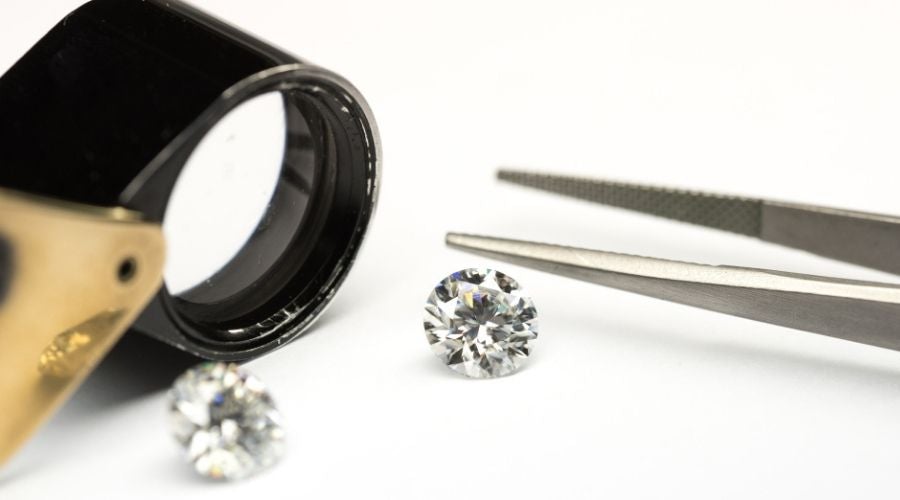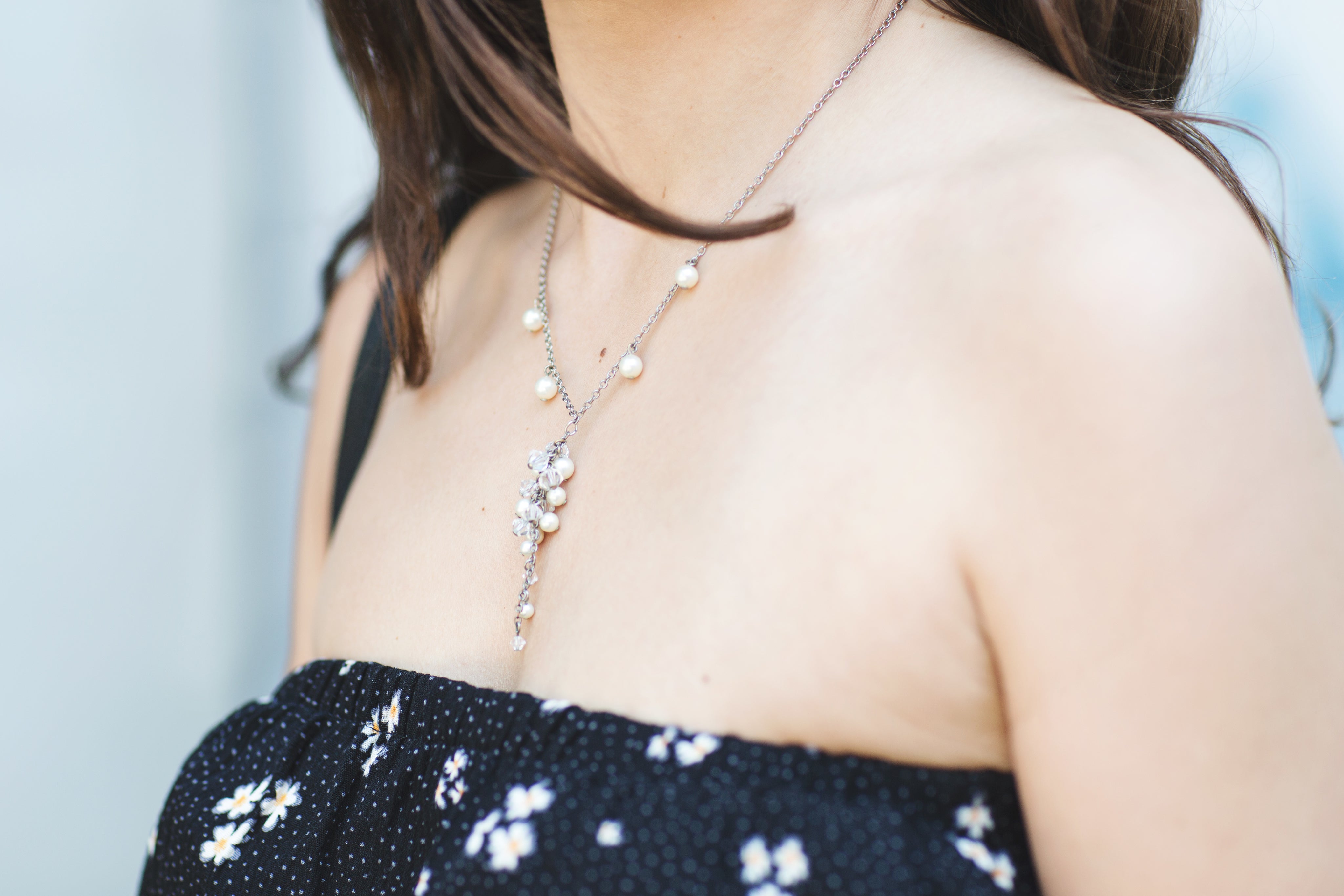
White and clear gemstones have always been popular, from jewelry to tools to spiritual instruments. The importance of crystals featured in early historical records, including Roman historian Pliny the Elder (23–79 AD) and medieval poetry.
Most white gemstones can suit any skin tone, casing material, cut, or style. Whether colorless or snowy, a white gemstone or crystal is classy, stylish, and sophisticated. Diamonds and pearls might be the most sought-after, but brilliant alternatives to white gemstones exist, from beryl to tourmaline.
The 17 Most Popular White & Clear Gemstones
Each type of white or clear gemstone has its own unique physical features, so it’s worthwhile to compare them to see which ones have the qualities you are looking for.
1. White Coral

White coral, also known as Safed Moonga, is a semi-precious gemstone. Although found in other colors, white is the predominant shade. Significantly, 75% of white coral is collected from Torre del Greco, Italy. To protect marine life, stricter guidelines have restricted harvesting. Unfortunately, a warming sea has negatively impacted coral growth.
The most delicate on our list, white coral, has a 3.5 Mohs scale rating, which rates minerals for scratch resistance and hardness.
Pros
- Unique, satiny texture
- Style flexibility (casual to formal)
Cons
- Unsustainable harvesting
2. Cat’s Eye Moonstone

Much like the magical glow of a cat's eye at night, the cat's eye moonstone has a remarkable reflective sheen, known as chatoyancy. The white and blue color variations are the most desirable and rare for the more transparent body.
While jewelers can form the stone as a ring, its vulnerability to scratches (6-6.5 Mohs scale) makes it a better match for other jewelry items, such as necklaces.
Pros
- Unique shine
- Some durability
Cons
- Rare
3. Diamonds

Although diamonds are commonly known as the hardest material on earth, other materials have surpassed stone's record. However, it's still number 7 for the hardest substance found or created on earth.
Most are familiar with the white diamond, but there are more than ten color varieties, from pink to black.
As the April birthstone and the go-to for wedding rings, it's one of the most sought gemstones in the world. Unfortunately, its popularity has led to terrifying practices, such as blood or conflict diamonds. Therefore, it's crucial to check for ethical diamond sourcing practices before buying.
Pros
- Highest durability (10 Mohs scale)
- Valuable
Cons
- Costly
4. Goshenite

Goshenite, a type of beryl, is known as the “mother of all gemstones.” Due to its clarity, goshenite was used to create the first eyeglasses. The significance likely led to goshenite’s association with improving eyesight.
It’s a 7.5-8 on the Mohs scale with a similar value to another beryl stone, aquamarine.
Pros
- Moderately priced
- Impressive clarity
Cons
- Limited market availability
5. Howlite

Howlite is a borate mineral often discredited as a gemstone. Although not heavily featured by traditional jewelers, it is nevertheless a popular gemstone for decor and ornamentation. Like jade and marble, artisans prize howlite as a stone canvas.
Howlite has dark veins with marble or porcelain-like texture. The variety of colors can range from opaque to transparent. White or clear howlite is the rarest variety and the most valuable.
Pros
- Abundant
- Unique coloring
Cons
- Delicate (3.5 Mohs scale)
6. Pearls

Harvested from mollusks and oysters, humans have valued pearls for centuries. Its unique iridescent shine birthed the descriptor: pearlescent. Yet, even the lesser-known black pearl has the signature sheen.
Pearls were once exclusive to the very wealthy, but cultured pearls have increased the availability, improving affordability and ethical sources. Notably, pearls continue to be considered sophisticated and can help dress up any style.
It's the most brittle on our list. Pearls rank between 2.5-4 on the Mohs scale.
Pros
- Classy and valuable
- Distinctive pearlescence
Cons
- Vulnerable to damage
7. Moonstone

Moonstone is known for its smooth, brilliant shine. Moonstones, available in a variety of colors, have a pearly luster. It can have mystical energy, like its namesake. However, it suits any skin tone and can match any style.
While moonstone can match well with any metal or jewelry setting, it's only 6-6.5 on the Mohs scale. As a result, designers typically use moonstone for costume jewelry or decor, as it's a softer material.
Pros
- Remarkable shine
- Versatile style
Cons
- Less affordable
8. Scolecite

Scolecite belongs to the zeolite group, characterized by soft stones with pale colors. Although there are multiple colors, the most abundant is colorless or white. It's brittle, with a Mohs scale rating of 5 to 5.5.
The smooth stone has chalky striations. However, the quality of the markings can appear differently depending on the opaqueness.
Pros
- Inexpensive
- Unique coloring/patterning variations
Cons
- Limited durability
9. Sodalite

Although best known for its blue color, sodalite can form multiple colors, including white. Sodalite samples are opaque in larger formations, but smaller specimens tend to be translucent. The more striking blue and the white both feature white veining.
Sodalite is quite soft at 5-5.5 on the Mohs scale. However, while it can suit any setting or style, it's brittle. As a result, designers most frequently feature sodalite in earrings, bracelets, and decorative pieces.
Pros
- Inexpensive
- One-of-a-kind patterning
Cons
- Fragile
10. White Agate

Agate is available in a variety of colors, usually forming alternating bands. White agate can range from translucent to milky white. Rather than sparkly, it has a waxy shine.
White agate can be ideal for costume jewelry. The semi-precious gems are less expensive to form a set, including earrings, necklaces, and large jewelry items. In addition, it ranges from 6.5 to 7 on the Mohs scale, which is one reason it's more affordable and better for costume jewelry.
Pros
- Unique colors/patterns
- Affordable
Cons
- Delicate
11. White Jade

When most people think jade, they think green. However, green and white jade are small samplings of available colors. Jade has two varieties: nephrite and jadeite. Nephrite is more affordable and readily available, but jadeite is more valuable and of higher quality.
White jade ranks 6 on the Mohs scale. The softness and smooth texture have long made it valuable for carvings and sculptures. It’s also relatively easy to set into various styles and include distinct engravings.
Pros
- Options for any budget
- Matches most complexions and settings
Cons
- Damaged easily
12. White Jasper

White jasper is a quartz variety with compactness similar to jade, although slightly higher on the Mohs scale between 6.5-7. Jasper is a crystal for courage, with additional connotations of hope and new beginnings for the white variety.
Most jasper varieties, including white, are common and therefore relatively affordable. The stone is opaque, with unique patterns created during formation.
Pros
- Affordable
- Wide variety
Cons
- Limited durability
13. White Opals

White opals, also known as milk opals or light opals, are the most common type of opal. It shares the October birthstone slot with tourmaline, although usually the pink version rather than the white.
Opals have a high water content, anywhere from 5-20%, which can impact the weight and integrity of the specimen. Moisture won’t affect everyday storage. However, low humidity or hot environments can dry or damage the stone. Using a sealable bag and a slightly damp cloth can prevent dehydration.
Pros
- Inexpensive
- Sophisticated
Cons
- Requires extra care
14. White Quartz

Quartz has a glass-like appearance, but it's much sturdier at 7 on the Mohs scale. In addition, it's more abundant than many stones on our list, which has made it a popular gem.
Generally, designers feature white quartz in oversized fashion items or statement pieces.
One exceptional variety, white rutile quartz, is characterized by needle-like rutin crystals formed within a section of quartz. Sometimes, crystal growths are created from a similar color to the exterior gemstone. Others might have a differing shade.
Although not rare, high demand sometimes inflates prices for white rutilated quartz.
Pros
- Affordable
- Plentiful availability
Cons
- Porous (can absorb stains)
15. White Sapphire

The white sapphire is commonly a substitute for white diamonds, as they’re generally more affordable and share a similar appearance. However, larger sapphires can have a cloudy or diluted appearance. With a 9 on the Mohs scale, the sapphire is still a hard mineral, if not the top slot.
The blue color for sapphire is September's birthstone. Still, jewelers can sometimes slip in the white version for April or September.
Pros
- Durable
- Precious stone
Cons
- Larger specimens tend to be cloudy
16. White Topaz

One rank lower than sapphire on the Mohs scale and more affordable, the white topaz is another stone featured for wedding rings. Blue topaz is more expensive as the white variety is more common. It can have a foggy quality like sapphire, making it essential to keep the stone clean to prevent exterior imperfections.
White topaz can range from a soft white to completely colorless.
Pros
- Affordable
- Higher availability
Cons
- Requires regular cleaning
17. Zircon

One of the earliest diamond substitutes, Zircon is another more affordable stone. One of the oldest materials known to humankind, zircon ranks between 6-7.5 on the Mohs scale. Its remarkable shine, known as pleochroism, reflects changing colors when observed at different angles.
However, it’s vulnerable to scratching and chipping.
Pros
- Denser than diamond
- Pleochroism
Cons
- Relatively breakable
White & Clear Gemstones Shopping Guide
There are many varieties of white or clear gemstones. While the array improves the chances of finding what you're looking for, it can also make choosing more challenging.
Color is often the most significant consideration. Sometimes buyers can give appearance higher priority than the gemstone quality or type. Nevertheless, a durable gemstone has higher longevity. If you want tougher, seek a higher Mohs scale rating. Diamonds might be the easy winner, but remember that sapphires are a close second.
Always ask if treatments have been conducted and request a certificate of authenticity. While it's crucial to choose a licensed seller, it's also helpful if the vendor has credible reviews or feedback from clients.
If you’re buying online, only buy from sellers that provide images or videos of their gemstones. Never trust stock images or drawings.
The vendor should also provide stone grading reports from reputable sources, such as the GIA (Gemological Institute of America) or AGS (American Gem Society). A grading report details the characteristics of a gemstone. In addition to helping you get what you pay for, it can also identify the gemstone’s country of origin.
Understanding and evaluating a gemstone from a third-party source can help ensure ethical practices. For example, assess how the gemstone was mined or created, such as lab-grown stones or responsible mining efforts. For jewelry that’s high quality, handmade, and ethical, show the collections at Lexie Jordan Jewelry.






Leave a comment